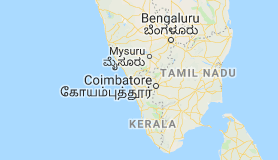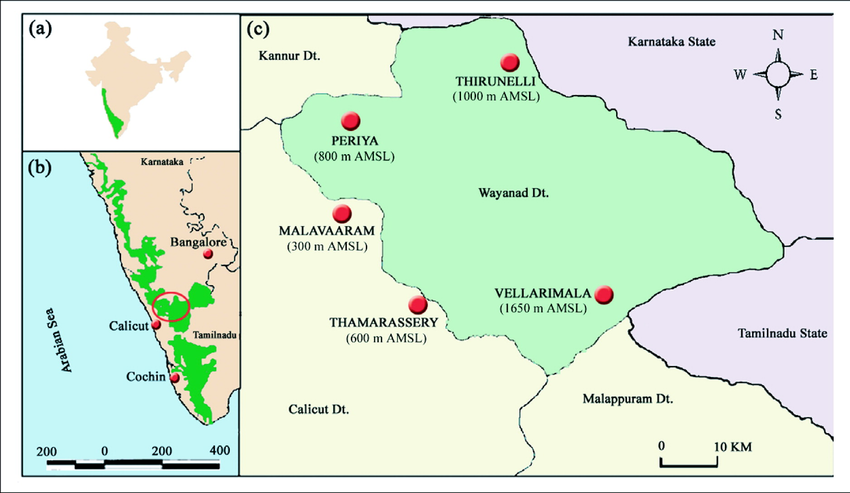Naxals to Expand Base at Tri-Junction of Kerala, Karnataka & Tamil Nadu states

According to an India government intelligence report, “in a few years Naxalism will have a consolidated front in Western Ghats and tri-junction area.”
New Delhi: Naxals are on the verge of creating a ‘consolidated front’ on the Western Ghats.
The tri-junction being the dense forests of the region where the states of Karnataka, Tamil Nadu and Kerala meet.
Naxals are expanding at an alarming rate in this region because of three main reasons.
— First is the nature of area that Naxals are exploiting—places which have least government penetration and consequently maximum dissatisfaction against the state.
The Naxal division working specifically on this region, being squeezed by forces on all sides in Bastar area, is Western Ghats Special Zonal Committee (WGSZC).
Over the past few weeks, the report states, “most number of Naxal sightings were from Wayannad, Mallapuram, Kannur, Kozhikode and Palakkad districts of Kerala and in terms of human development indicators these districts lie at the bottom, thus, constituting perspective area for naxal growth and operation.”
— The other problem is that Naxals have set their bases up in, as the report states, the “unexplored jungles” in the tri-junction region. This is the area that was under firm control of the brigand Veerappan.
So while “Tamil Nadu police and Karnataka police had a firsthand experience of the jungle in their respective states due to the forest brigand Veerappan,” Kerala still has very little knowledge about the topography, which has resulted in a rapid expansion by Naxals in this area.
According to intelligence shared by police departments of Tamil Nadu and Karnataka with central agencies, Naxals are also getting familiarised and trained according to the terrain. Arms training is regularly being undertaken in dense jungles of Wayanad.
Due to the frequent operations by Anti-naxal Force and the special task forces of Karnataka and Tamil Nadu Naxals were forced to flee towards the jungle areas of Kerala, the intel report adds.
“But for Kerala, combing operation is new to them and requires assistance. Kerala has vast jungle areas that are left unexplored.”
— There is yet another hurdle for the forces to deal with in order to counter the growing influence of Naxals in the tri-junction area—since in the dense forests there is no way to mark boundaries, problems of jurisdiction arise. These problems can only be dealt with a coordinating agency for conducting anti-Naxal operations for all the three states. Such an authority does not exist so far.
All these issues have come together to fuel activities of Naxal fronts that have “increased considerably” in places like Erode, which lies in Tamil Nadu, but is close to both Karnataka and Kerala.
Senior officers say that the Kerala has been identified to be “vulnerable” due to less manpower and inadequate weaponry. This has caused the three states to demand deployment of central troops just as is the case in the Dandakaranya zone which includes parts of Chhattisgarh, Odisha, Telangana and Andhra Pradesh.
Naxals regrouping in Tamil Nadu, Kerala, Karnataka: Police
In a first since 2005, there have been sightings of Maoist groups in the Western Ghats, says an intelligence report

The Maoists’ main recruitment is from Karnataka and Chhattisgarh, but they prefer to stay in Kerala parts of the Western Ghats, according to an intelligence report. Photo: HT
Wayanad (Kerala): The Kerala and Karnataka Police as well as intelligence agencies say there has been a strong Maoist resurgence in the Kerala-Karnataka-Tamil Nadu (KKT) region, in what could deal a blow to the Union government’s efforts to contain Left-wing extremism (LWE) in the country,
After a hiatus of nearly 12 years following the 2005 killing of Saketh, a Karnataka state committee member of the Communist Party of India (Maoist), the group has started making a comeback in the KKT tri-junction, according to an intelligence report reviewed by Mint.
“Currently the Western Ghat zonal committee is run by B.G Krishnamurthy and militarily supported by Vikram Gowda. Their main recruitment is from Karnataka and Chhattisgarh, but they prefer to stay in Kerala parts of Western Ghats. There have been sightings and four groups are operating in the Kerala side of Western Ghats,” the report said.
“In September 2017, five armed Maoist cadres forced their way into a house at Parappanpara in Kerala’s Kozhikode district. Having robbed the owner of basic supplies and food, they warned him against contacting the police, and fled. The next day, the Kerala Police embarked on a massive combing and search operation against the group in the nearby forest areas, only to find that the group had escaped without a trace,” said a senior Kerala Police official, seeking anonymity.
Though they could not be located, the team of Maoists (of that particular group) was led by Soman, who hails from Wayanad and is also a former leader of another Maoist front organization, the official added.
While the Kannadiga cadre of the Maoists has suffered a decline because of the gradual shift to Kerala, senior state police officials said that the southern tip of Karnataka, overlapping with Kerala and Tamil Nadu had become a safe haven for the CPI (Maoist) cadres who had begun to retreat from their current strongholds in the Andhra-Odisha border.
“To strengthen themselves, they are planning to develop morally, militarily and their organization capabilities. They are planning to train uneducated cadres by giving them both tactical and political education,” the aforementioned report said.
On 21 April 2017, the Kerala Police conducted another round of combing operations in the Nilambur Forest in Malappuram district after receiving reports of a Maoist group camping inside the forest and intelligence units in the state confirmed “that the group had planted landmines around their camp near the Mancheeri Tribal Colony, in an apparent bid to prevent police raids. A group of armed cadres had also warned the Mancheeri Colony residents of landmines and had asked them not to enter their camp area.”
Experts said that state borders were more porous, given lower levels of policing.
“State borders are less policed and so Naxal movement is easy there. But there needs to be more specific intelligence on their movement and where they will hit next,” said Gurmeet Kanwal, defence analyst at the Institute of Defence Studies and Analyses in New Delhi.


.jpg)
No comments:
Post a Comment